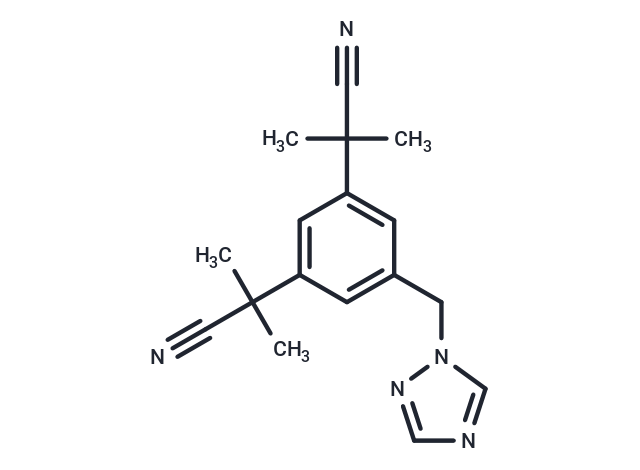Shopping Cart
Remove All Your shopping cart is currently empty
Your shopping cart is currently empty
Anastrozole (ZD1033)(ZD1033), a potent and highly selective aromatase (CYP19) inhibitor (IC50 = 15 nM), has no obvious effect on adrenocorticoid hormone synthesis.

| Pack Size | Price | USA Warehouse | Global Warehouse | Quantity |
|---|---|---|---|---|
| 10 mg | $45 | In Stock | In Stock | |
| 25 mg | $61 | In Stock | In Stock | |
| 50 mg | $77 | In Stock | In Stock | |
| 1 mL x 10 mM (in DMSO) | $48 | In Stock | In Stock |
| Description | Anastrozole (ZD1033)(ZD1033), a potent and highly selective aromatase (CYP19) inhibitor (IC50 = 15 nM), has no obvious effect on adrenocorticoid hormone synthesis. |
| Targets&IC50 | Aromatase:15 nM |
| In vitro | Administration of Anastrozole (>9.1 mg/kg) twice daily to male cynomolgus monkeys inhibits peripheral aromatase activity, reducing circulating estradiol concentrations by 50% to 60%. Oral dosing of mature rats every 2 to 3 estrous cycles with 0.1 mg/kg of Anastrozole blocks ovulation in mature female rats; administering certain doses for 3 days to pubescent rats completely inhibits uterine growth stimulated by androstenedione. These effects may be due to the suppression of the pre-ovulatory surge in estrogen synthesis within the follicles of mature female animals and the inhibition of immature ovarian metabolism of exogenous androstenedione in pubescent females. |
| In vivo | Anastrozole binds to the heme group within the aromatase CYP unit, competitively inhibiting the enzyme and consequently reducing estrogen biosynthesis in breast tissue and peripheral areas. It has negligible effects on other steroid hormones. In vitro, Anastrozole exhibits high inhibitory potency, with an IC50 of 15 nM against human placental aromatase. Its efficacy is twice that of 4-OHA, 200 times that of AG, and a third of that of fadrozole. |
| Kinase Assay | Aromatase inhibition is measured using human placental microsomes and the method of Thompson and Siiteri with Testosterone (0.5 μM) as substrate. 11-hydroxylase inhibition is determined by measuring the conversion of [1,2,6,7-3H]-ll-deoxy- cortisol to cortisol using freshly prepared mitochondria from guinea pig, dog and cow adrenal glands. Reaction products are extracted into chloroform and separated by thin layer chromatography[1]. |
| Synonyms | ZD1033 |
| Molecular Weight | 293.37 |
| Formula | C17H19N5 |
| Cas No. | 120511-73-1 |
| Smiles | C(C#N)(C)(C)C1=CC(C(C#N)(C)C)=CC(CN2C=NC=N2)=C1 |
| Relative Density. | 1.08 g/cm3 (Predicted) |
| Storage | Powder: -20°C for 3 years | In solvent: -80°C for 1 year | Shipping with blue ice/Shipping at ambient temperature. | ||||||||||||||||||||||||||||||||||||||||
| Solubility Information | DMSO: 60 mg/mL (204.52 mM), Sonication is recommended. Ethanol: 29.3 mg/mL (99.87 mM), Sonication is recommended. | ||||||||||||||||||||||||||||||||||||||||
| In Vivo Formulation | 10% DMSO+40% PEG300+5% Tween 80+45% Saline: 2 mg/mL (6.82 mM), Sonication is recommended. Please add the solvents sequentially, clarifying the solution as much as possible before adding the next one. Dissolve by heating and/or sonication if necessary. Working solution is recommended to be prepared and used immediately. The formulation provided above is for reference purposes only. In vivo formulations may vary and should be modified based on specific experimental conditions. | ||||||||||||||||||||||||||||||||||||||||
Solution Preparation Table | |||||||||||||||||||||||||||||||||||||||||
Ethanol/DMSO
DMSO
| |||||||||||||||||||||||||||||||||||||||||
| Size | Quantity | Unit Price | Amount | Operation |
|---|

Copyright © 2015-2025 TargetMol Chemicals Inc. All Rights Reserved.